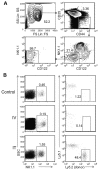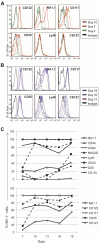Development of thymic NK cells from double negative 1 thymocyte precursors
- PMID: 21821702
- PMCID: PMC3186333
- DOI: 10.1182/blood-2011-06-359679
Development of thymic NK cells from double negative 1 thymocyte precursors
Abstract
The differentiation of natural killer (NK) cells and a subpopulation of NK cells which requires an intact thymus, that is, thymic NK cells, is poorly understood. Previous in vitro studies indicate that double negative (CD4⁻CD8⁻, DN) thymocytes can develop into cells with NK cell markers, but these cells have not been well characterized. Herein, we generated and characterized NK cells differentiating from thymic DN precursors. Sorted DN1 (CD44⁺CD25⁻) CD122⁻NK1.1⁻ thymocytes from Rag1(⁻/⁻) mice were adoptively transferred into Rag1(⁻/⁻)Ly5.1 congenic mice. After intrathymic injection, donor-derived cells phenotypically resembling thymic NK cells were found. To further study their differentiation, we seeded sorted DN1 CD122⁻)NK1.1⁻ thymocytes on irradiated OP9 bone marrow stromal cells with IL-15, IL-7, Flt3L, and stem cell factor. NK1.1⁺ cells emerged after 7 days. In vitro differentiated NK cells acquired markers associated with immature bone marrow-derived NK cells, but also expressed CD127, which is typically found on thymic NK cells. Furthermore, we found that in vitro cells generated from thymic precursors secreted cytokines when stimulated and degranulated on target exposure. Together, these data indicate that functional thymic NK cells can develop from a DN1 progenitor cell population.
Figures






Similar articles
-
Effect of Schlafen 2 on natural killer and T cell development from common T/natural killer progenitors.Pak J Biol Sci. 2011 Nov 15;14(22):1002-10. doi: 10.3923/pjbs.2011.1002.1010. Pak J Biol Sci. 2011. PMID: 22514877
-
Regulation of NK1.1 expression during lineage commitment of progenitor thymocytes.J Immunol. 1998 Dec 15;161(12):6544-51. J Immunol. 1998. PMID: 9862680
-
The transcription factor E4BP4 is not required for extramedullary pathways of NK cell development.J Immunol. 2014 Mar 15;192(6):2677-88. doi: 10.4049/jimmunol.1302765. Epub 2014 Feb 17. J Immunol. 2014. PMID: 24534532 Free PMC article.
-
Involvement of CCR9 at multiple stages of adult T lymphopoiesis.J Leukoc Biol. 2008 Jan;83(1):156-64. doi: 10.1189/jlb.0607423. Epub 2007 Oct 2. J Leukoc Biol. 2008. PMID: 17911179
-
Expression of BMPRIA on human thymic NK cell precursors: role of BMP signaling in intrathymic NK cell development.Blood. 2012 Feb 23;119(8):1861-71. doi: 10.1182/blood-2011-07-370650. Epub 2011 Dec 30. Blood. 2012. PMID: 22210872
Cited by
-
Phenotype and functions of conventional and non-conventional NK cells.Curr Opin Immunol. 2016 Feb;38:67-74. doi: 10.1016/j.coi.2015.11.007. Epub 2015 Dec 17. Curr Opin Immunol. 2016. PMID: 26706497 Free PMC article. Review.
-
Feeder-cell-free system for ex vivo production of natural killer cells from cord blood hematopoietic stem and progenitor cells.Front Immunol. 2025 Feb 20;16:1531736. doi: 10.3389/fimmu.2025.1531736. eCollection 2025. Front Immunol. 2025. PMID: 40051631 Free PMC article.
-
The divergence between T cell and innate lymphoid cell fates controlled by E and Id proteins.Front Immunol. 2022 Aug 10;13:960444. doi: 10.3389/fimmu.2022.960444. eCollection 2022. Front Immunol. 2022. PMID: 36032069 Free PMC article. Review.
-
Tissue-Resident NK Cells: Development, Maturation, and Clinical Relevance.Cancers (Basel). 2020 Jun 12;12(6):1553. doi: 10.3390/cancers12061553. Cancers (Basel). 2020. PMID: 32545516 Free PMC article. Review.
-
Regulation of murine natural killer cell commitment.Front Immunol. 2013 Jan 30;4:14. doi: 10.3389/fimmu.2013.00014. eCollection 2013. Front Immunol. 2013. PMID: 23386852 Free PMC article.
References
-
- Yokoyama WM. Chapter 17, Natural killer cells. In: Paul WE, editor. Fundamental Immunology. New York, NY: Lippincott-Raven; 2008. pp. 483–517.
-
- Yokoyama WM, Kim S, French AR. The dynamic life of natural killer cells. Annu Rev Immunol. 2004;22:405–429. - PubMed
-
- Di Santo JP. Natural killer cell developmental pathways: a question of balance. Annu Rev Immunol. 2006;24:257–286. - PubMed
-
- Igarashi H, Gregory SC, Yokota T, Sakaguchi N, Kincade PW. Transcription from the RAG1 locus marks the earliest lymphocyte progenitors in bone marrow. Immunity. 2002;17(2):117–130. - PubMed
Publication types
MeSH terms
Substances
Grants and funding
LinkOut - more resources
Full Text Sources
Medical
Research Materials
Miscellaneous

